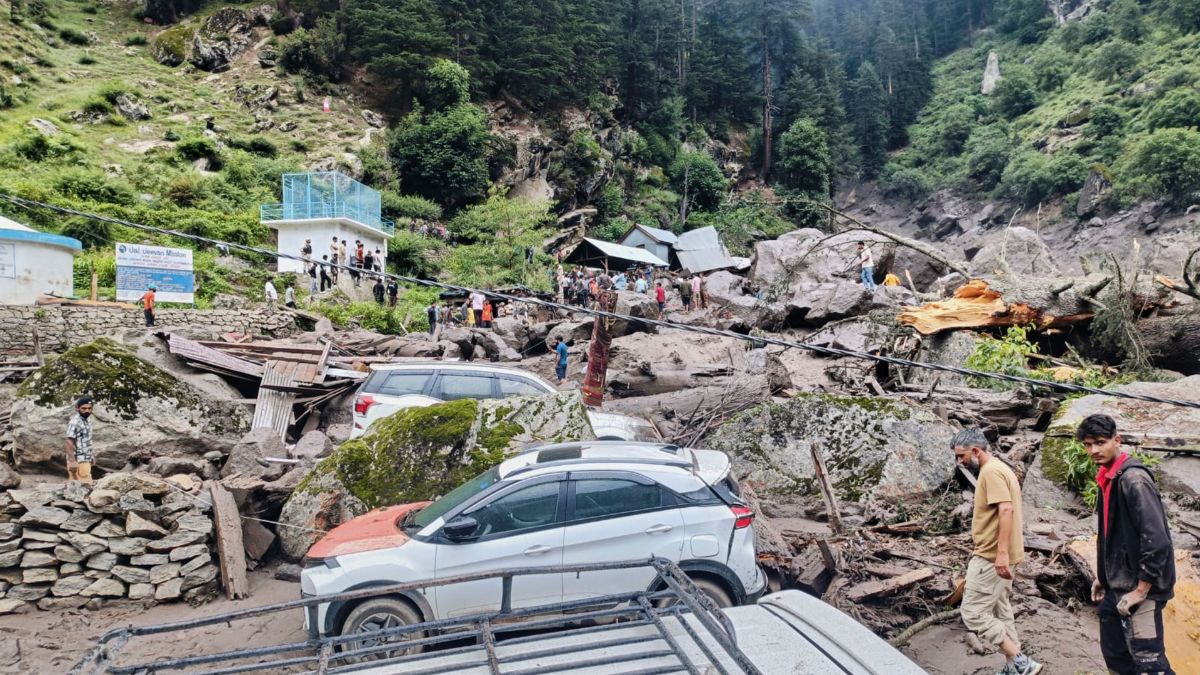Days after Uttarakhand, Jammu and Kashmir reported a cloudburst that triggered flash floods. At least 30 people died and dozens of others were injured on Thursday (August 14) when a massive cloudburst struck a remote mountain village in the Kishtwar district.
The tragedy occurred at Chashoti, the last motorable village en route to the Machail Mata temple, earlier in the day. The incident has once again sparked concerns about such disasters that leave a trail of death and destruction.
Let’s take a closer look.
What is a cloudburst?
A cloudburst is a sudden, intense downpour of rain that occurs over a small area in a short period.
An event is defined as a cloudburst when rainfall of about 10 cm or above per hour is recorded over a place nearly 10 km x 10 km in area.
Cloudbursts are more common in mountainous regions during monsoons. At higher altitudes, moisture-laden clouds are unable to generate rain owing to the upward movement of a very warm current of air.
This air current carries raindrops upwards. As they rise, new drops are formed and existing ones grow in size. When the raindrops become too heavy for the cloud to hold, they drop down suddenly at once.
Ruchit Kulkarni, an Indian meteorologist studying extreme rainfall at the University of Melbourne, told The Guardian that in the Himalayan foothills, moisture that often comes from the Arabian Sea to the west is swept up by mountains in a phenomenon known as orographic lift.
This forms cumulonimbus clouds that can accumulate large rain droplets. “So we have this moist airflow being lifted up and the cloud gets bigger and bigger and with no chance to have rainfall, it becomes so heavy that at a point, it starts bursting,” explained Kulkarni.
This sudden, heavy rain released due to a cloudburst can quickly overwhelm drainage systems in hilly areas, triggering flash floods and landslides.
What happened in J&K’s Kishtwar?
At least 38 people, including two Central Industrial Security Force (CISF) personnel, lost their lives after a cloudburst hit the remote mountain village of Chashoti in J&K’s Kishtwar district.
The death toll could increase, officials have warned, as per PTI. Reports say that 120 people have been rescued, of whom 38 are in serious condition.
The cloudburst sparked flash floods at Chashoti village, where many devotees had gathered for the annual Machail Mata yatra.
VIDEO | Kishtwar, Himachal Pradesh: Massive cloudburst hits the region; visuals show extensive damage and panic in affected areas.
— Press Trust of India (@PTI_News) August 14, 2025
(Full video available on PTI Videos - https://t.co/n147TvrpG7) pic.twitter.com/5K36ADrKqh
The 8.5-kilometre trek to the 9,500-feet-high temple begins from this village, which is about 90 kilometres from Kishtwar town.
Flash floods washed away several structures, including shops and a security outpost. A langar (community kitchen) set up for the devotees witnessed the brunt of the disaster.
Rescue operations are underway, with teams of the National Disaster Response Force (NDRF), State Disaster Response Force (SDRF), police, Indian Army and local volunteers on the ground.
Army’s White Knight Corps said efforts are on to safeguard lives and help the survivors.
Prime Minister Narendra Modi, President Droupadi Murmu, and Jammu and Kashmir Chief Minister Omar Abdullah were among those to express anguish over the tragedy.
Union Home Minister Amit Shah spoke with J&K Lieutenant Governor Manoj Sinha and CM Abdullah, assuring “all possible assistance”.
ALSO READ: How flash floods wreaked havoc in Uttarakhand village
Why is J&K vulnerable?
Jammu and Kashmir’s topography makes it prone to natural disasters such as earthquakes, floods, landslides, avalanches, and snowstorms.
The region has also seen a rise in instances of cloudbursts and flash floods in recent years.
As per a Greater Kashmir report, the melting of glaciers has led to the formation of glacial lakes in the mountain ranges of Kashmir. As temperatures increase due to global warming, there is an enhanced risk of Glacial Lake Outburst Floods (GLOF).
The Himalayas are warming, which has caused erratic weather patterns in the region. In Jammu and Kashmir, this makes communities and infrastructure more prone to cryosphere-related hazards, the report noted.
The problem could be more devastating if cloudbursts were reported near glacial lakes. Cloudbursts can trigger flash floods in these lakes.
Moreover, the Glacial Lake Outburst Floods would severely impact downstream populations due to the sudden outburst of glacial lakes.
With inputs from agencies


)

)
)
)
)
)
)
)
)



